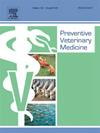Time series modelling of swine lung lesion prevalence to predict the temporal dynamics of Mycoplasma hyopneumoniae and Actinobacillus pleuropneumoniae infections in Spain
IF 2.4
2区 农林科学
Q1 VETERINARY SCIENCES
引用次数: 0
Abstract
Respiratory diseases are considered one of the most important problems in swine production worldwide due to the significant economic losses associated. Lung lesion evaluation at slaughterhouses by different scoring systems is commonly used to monitor respiratory diseases in swine. Concretely, cranioventral pulmonary consolidation lesions are associated with enzootic pneumonia (EP) caused by Mycoplasma hyopneumoniae (Mhyo); whereas haemorrhagic necrotizing pneumonia, mainly in the dorso-caudal lung lobes, and chronic pleuritis (CP) are associated with Actinobacillus pleuropneumoniae (App). Despite the recent consideration of several statistical methods for modelling the temporal dynamics of diseases and the construction of monitoring systems, none have been applied to lung lesions data collected at slaughterhouses. Thus, this work aimed (1) to describe the temporal patterns of EP and CP-like lesions in Spain using time series methods to model the collected data on lung lesions at slaughterhouses; and (2) to construct and evaluate in quasi-real time a surveillance system for early detection of outbreaks and abnormal trends potentially related to both pathogens. In total, 16 time series were analysed including 3947 audits from 474 Spanish farms associated with 302 companies between 2016 and 2019. The monthly time series of the EP index between 2016 and 2019 in Spain (point estimate for Spain was −0.088 with an associated p = 0.073) and different Spanish subregions showed decreasing trend patterns (point estimates for Aragon was −0.028 with an associated p = 0.000 and for Catalonia was −0.064 with an associated p = 0.092), whereas the monthly time series of the CP index increased (point estimate for Spain was 0.004 with an associated p = 0.045 and for Aragon was 0.007 with an associated p = 0.000) over the same period. Additionally, the predictive performance of the estimated models was evaluated at quasi-real time using the data between 2020 and 2021. Results from this evaluation showed that overall, the selected models predicted the evolution of both the EP and CP indices in a reasonable manner being between 90 % prediction intervals. Therefore, time series models constructed in this work could be used to prevent and shorten the response time in implementing of control strategies against these respiratory pathogens minimizing their economic impact associated.
西班牙猪肺病变流行率的时间序列模型预测肺炎支原体和胸膜肺炎放线杆菌感染的时间动态
呼吸道疾病被认为是全球猪业生产中最重要的问题之一,因为会造成重大的经济损失。屠宰场通过不同的评分系统对肺部病变进行评估,通常用于监测猪的呼吸道疾病。具体来说,颅腹部肺部合并病变与由肺炎支原体(Mhyo)引起的猪肺疫(EP)有关;而出血性坏死性肺炎(主要发生在背部-尾部肺叶)和慢性胸膜炎(CP)则与胸膜肺炎放线杆菌(App)有关。尽管最近考虑采用多种统计方法对疾病的时间动态进行建模并构建监测系统,但这些方法均未应用于屠宰场收集的肺部病变数据。因此,这项工作旨在:(1)使用时间序列方法对屠宰场收集的肺部病变数据建模,描述西班牙 EP 和 CP 类病变的时间模式;(2)构建和评估准实时监测系统,以便及早发现可能与这两种病原体有关的疫情爆发和异常趋势。共分析了 16 个时间序列,包括 2016 年至 2019 年期间与 302 家公司有关联的 474 个西班牙农场的 3947 次审计。2016 年至 2019 年期间,西班牙的 EP 指数月时间序列(西班牙的点估计值为-0.088,相关 p = 0.073)和西班牙不同次区域的 EP 指数月时间序列显示出下降趋势模式(阿拉贡的点估计值为-0.028,相关 p = 0.000,加泰罗尼亚为-0.064,相关 p = 0.092),而同期 CP 指数的月度时间序列则有所增加(西班牙的点估计值为 0.004,相关 p = 0.045,阿拉贡的点估计值为 0.007,相关 p = 0.000)。此外,还利用 2020 年至 2021 年的数据对估计模型的预测性能进行了准实时评估。评估结果表明,总体而言,所选模型对 EP 和 CP 指数的变化预测合理,预测区间在 90% 之间。因此,这项工作中构建的时间序列模型可用于预防和缩短针对这些呼吸道病原体实施控制策略的响应时间,最大限度地减少其相关的经济影响。
本文章由计算机程序翻译,如有差异,请以英文原文为准。
求助全文
约1分钟内获得全文
求助全文
来源期刊

Preventive veterinary medicine
农林科学-兽医学
CiteScore
5.60
自引率
7.70%
发文量
184
审稿时长
3 months
期刊介绍:
Preventive Veterinary Medicine is one of the leading international resources for scientific reports on animal health programs and preventive veterinary medicine. The journal follows the guidelines for standardizing and strengthening the reporting of biomedical research which are available from the CONSORT, MOOSE, PRISMA, REFLECT, STARD, and STROBE statements. The journal focuses on:
Epidemiology of health events relevant to domestic and wild animals;
Economic impacts of epidemic and endemic animal and zoonotic diseases;
Latest methods and approaches in veterinary epidemiology;
Disease and infection control or eradication measures;
The "One Health" concept and the relationships between veterinary medicine, human health, animal-production systems, and the environment;
Development of new techniques in surveillance systems and diagnosis;
Evaluation and control of diseases in animal populations.
 求助内容:
求助内容: 应助结果提醒方式:
应助结果提醒方式:


